5 Drills to Stay Healthy During Baseball Season
The start of baseball is almost upon us, so this seems like an appropriate time to talk about a few common problems that baseball and softball players can run into during the season. These are all fixable problems, but if left unchecked they can lead to injuries down the line, so it’s a good idea to get out in front of these issues and try to prevent them before they start.
Youth baseball players, especially those in their late tweens/early teens, may be at a higher risk of injury due to an increased load placed on their bodies during the season.
Around age 12, these athletes start playing longer seasons on bigger fields, with additional demands from fall ball to consider as well. Also, these athletes typically don’t participate in good offseason training programs to prepare their bodies for this kind of load. When you take young, unprepared athletes and subject their bodies to a much heavier load than they’re used to, injuries have a tendency to occur.
However, we know that baseball players tend to suffer similar injuries. They lose mobility and strength in similar areas, which means that we can be proactive and address these potential problems before they start, thereby greatly decreasing the likelihood that a baseball player will suffer an injury.
To that end, I wanted to discuss 5 things to focus on during the season to keep yourself healthy.
5 Drills to Stay Healthy During Baseball Season
Here are 5 easy drills to work on to proactively reduce the amount of baseball injuries.
1) Shoulder Internal Rotation Stretches
A common problem in throwing athletes is a loss of internal rotation in the throwing shoulder. This is especially prevalent among baseball pitchers, but it has the potential to arise in any throwing athlete.
Now, it is important to note that a loss of internal rotation is actually considered a “normal” finding in throwing athletes. Typically, a throwing athlete will exhibit less internal rotation, but more external rotation in their throwing shoulder. As long as the total range of motion of the shoulder (Internal Rotation + External Rotation) is roughly the same as that of the non-throwing shoulder, it’s not a big issue. But it’s a good idea to do some stretching on a regular basis to “maintain” an acceptable total ROM.
The cross-body stretch is gaining popularity over the sleeper stretch for restoring shoulder internal rotation ROM because it doesn’t put your shoulder into a “provocative” position, and gets similar – if not better – results compared to the sleeper stretch. To do the cross-body stretch, you can lay on your side or stand against a wall, then grab your elbow and pull across your body until you feel a stretch in the back of your shoulder. While doing this, you’ll need to focus on keeping your shoulder blade stable. If you can’t keep your shoulder blade from moving while you’re lying on your side, it’s best to do it against a wall to help keep your scapula in a fixed position.
The sleeper stretch has fallen out of favor somewhat in recent years, but can still be an effective method for restoring lost ROM if you do it correctly. To perform this stretch, Stack your shoulders one on top of the other, squeeze your shoulder blades together, and gently push your throwing arm hand towards the floor for 3 sets of 30-40 seconds.
2) Serratus Slide
Scapular winging is a common finding in baseball players, most often caused by weakness in the serratus anterior. Winging, like a loss of internal rotation, is another condition that is correlated with a higher risk of arm injury, so keeping the serratus anterior strong throughout the season should be a priority for any throwing athlete.
The key when performing a serratus slide is to make sure the shoulder blades are protracting and upwardly rotating instead of just shrugging, so think about trying to wrap your shoulder blades around the front of your body and push the elbows up without shrugging.
Perform 3 sets of 12-15 reps.
3) Internal Rotation Hip Stretch
Many people don’t consider the role of the hips when thinking about how to prevent arm injuries, but loss of internal rotation in the glove-side hip has been shown to be correlated with elbow pain during throwing and is thought to increase the risk of elbow injury. This loss of hip mobility is caused by the repetitive nature of throwing, and is most often found in pitchers.
There are a couple of ways to improve hip internal rotation ROM, the first of which is to bend both knees to 90 degrees, spread your feet as far apart as you can, then try to touch your knees together by internally rotating the hips.
The best way to do it, however, is to do a partner stretch with your hip flexed to 90 degrees. Lay on your back with your hip flexed to 90 degrees while your partner stabilizes the knee and internally rotates your leg. A 2014 study showed that a deficiency in hip internal rotation ROM at 90 degrees of hip flexion was correlated with higher incidences of elbow pain while hip ROM at 0 degrees of hip flexion was not. So it stands to reason that stretching in this hip-flexed position will have a better effect than otherwise. The goal should be to achieve 30-40 degrees of internal rotation on each hip. Hold each stretch for 3 sets of 30-40 seconds.
4) Bench Lat Stretch
The lats are a common tight muscle group in baseball and softball players, and this should be addressed in their post- and between-game stretching routines. Place one elbow on a bench, then use your opposite side hand to brace your arm and prevent it from internally rotating. From this position, push your chest towards the ground until you feel a stretch in your lat, keeping your core braced throughout the motion. You can also perform these while holding onto a dowel. Perform 2-3 sets of 15-20 2-second holds on each side.
5) Pec Minor Stretch
In addition to serratus anterior weakness, another potential cause of scapular winging is tightness in the pectoralis minor. This comes as a result of frequent throwing, and should be addressed with stretching and soft tissue work on the pec minor. The best way to stretch the pec minor by yourself is with the pec minor corner stretch, where you’ll place the front of your throwing shoulder against the corner of a wall, and then turn your head and body as far away from the wall as you can while maintaining a braced core and squeezing the shoulder blades together. Repeat for 3 sets of 30-40 seconds.
Try these 5 drills designed to prevent some of the common mobility and strength limitations that occur during a baseball season and you’ll be on your way to a healthy, and more effective, season.
Andrew Sacks
Latest posts by Andrew Sacks (see all)
- How to Prepare in the On-Deck Circle - May 8, 2018
- 5 Drills to Stay Healthy During Baseball Season - February 21, 2017


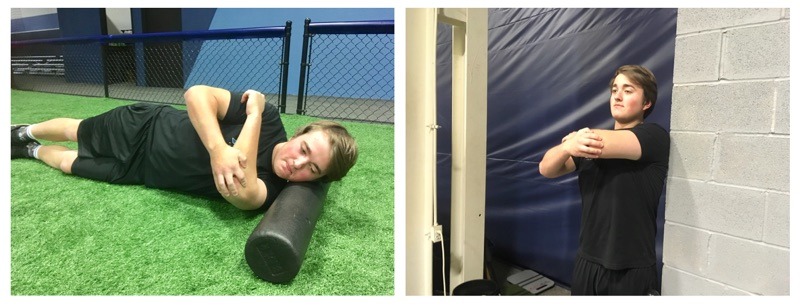
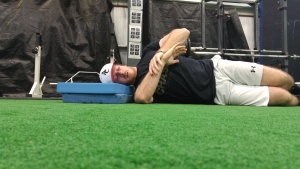
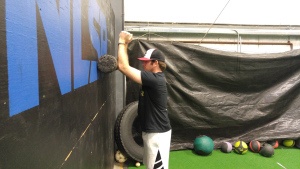
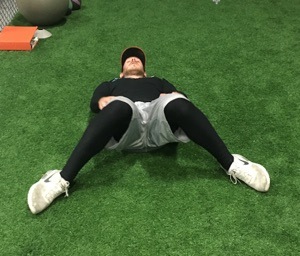
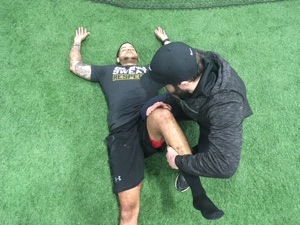

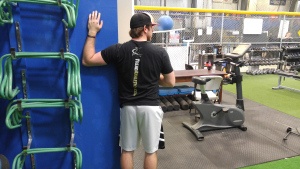


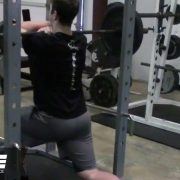
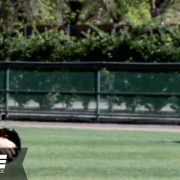




Regarding # 3 – The Internal Rotation Hip Stretch: it states that this stretch can help prevent elbow pain. Can it also help prevent “shoulder pain” in the throwing shoulder? Thanks Jim
Hi Jim, I think the concept is the same, for sure.
For the pec stretch, I have two questions. Isn’t that mostly a pec major stretch? Pec minor is deeper and harder to get too. I’ve heard if you raise your hand higher above your head you have a better chance of getting to that pec minor. Also, don’t you think the shoulder joint will glide anteriorly if you do that stretch. Aren’t we trying to avoid that?